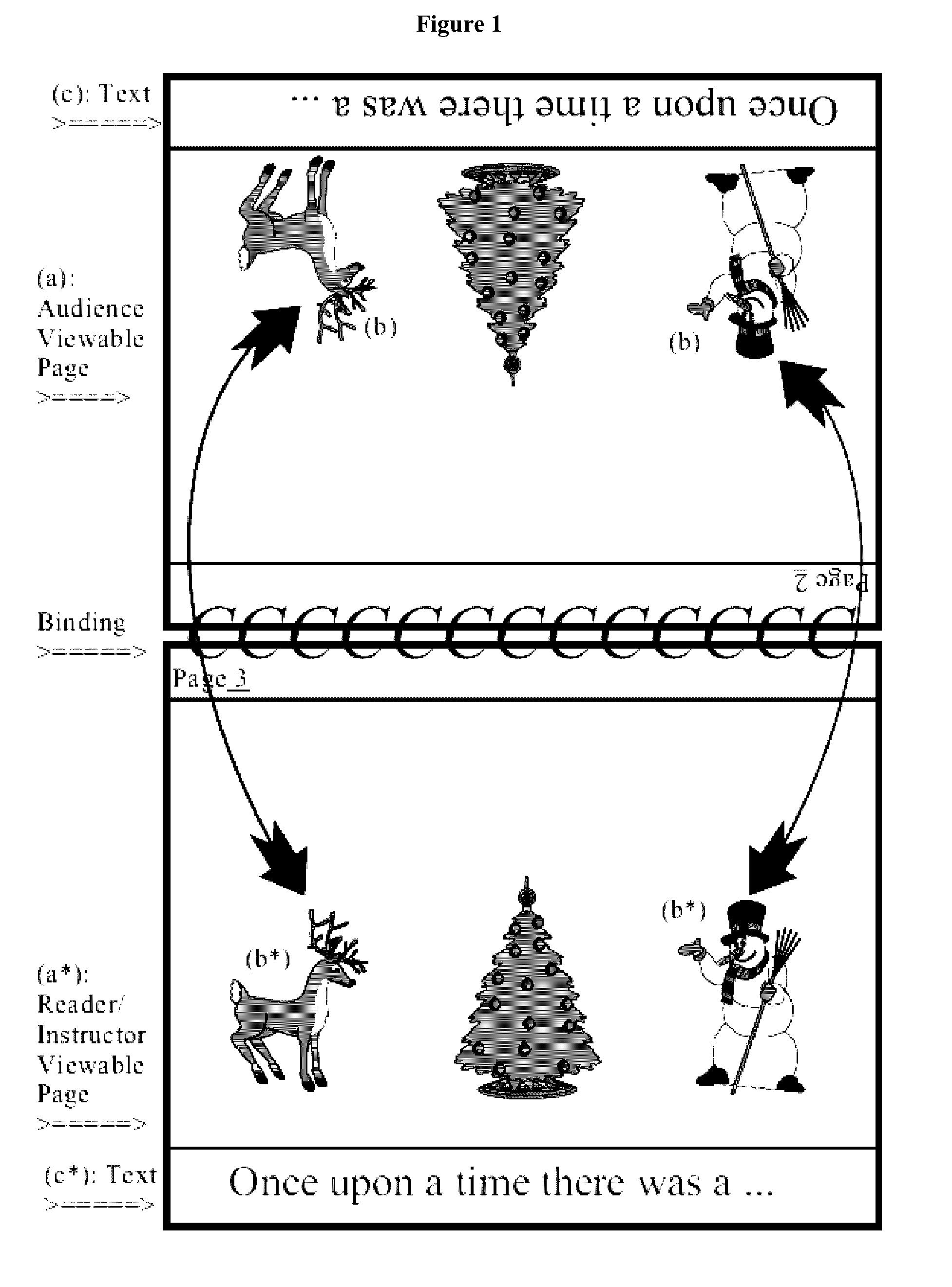Two-Way Read-and-Show Illustrated Flip-Over Storytelling or Picture Books and Aids
a flip-over and flip-over technology, applied in the field of illustrated books or aids, can solve the problems of not showing, teaching or even suggesting a story, person or persons, and being used as a test ki
- Summary
- Abstract
- Description
- Claims
- Application Information
AI Technical Summary
Benefits of technology
Problems solved by technology
Method used
Image
Examples
example 1
[0030]A storytelling book is bound by a plasticor metal coil, spiral spine or a plastic comb spine to facilitate the easy turning of the leaves of the bookor the standing up of the book in easel-like configuration and also to facilitate reading and telling of the story and use of the book.
[0031]The storytelling book has leaves with pages having consecutive page numbers 2-13, etc., wherein a set of pages with even page numbers, i.e., pages 2, 4, 6, 8, 10, 12, etc., are intended for viewing by the audience (“audience-facing pages”), and the corresponding set of pages with odd page numbers, i.e., pages 3, 5, 7, 9, 11, 13, etc., are intended for viewing by the instructor, storyteller, or reader (“reader-facing pages”). Each leaf with an audience-facing page (with even page number) has a corresponding separate and sequential adjacent leaf comprising a reader-facing page (with odd page numbers), wherein any image or illustration in the audience-facing page is a mirror image of an image or...
example 2
[0038]In an alternate example, the “c” text and corresponding non-symmetrical “b” pictures in the audience-facing “a” pages (with even page numbers) from a story are in close proximity on the same page, so that an audience of listeners may see the “b” picture and the “c” text while the storyteller is reading the corresponding “c*” text in the reader-facing pages “a*” on the separate and sequential adjacent leaf. In one embodiment, the “c” text is identical to, or related to, the “c*” text being read out loud to them by a reader. In this example, the textural material is disposed across page 20 with a non-symmetrical “b” graphic and “c” text facing the audience and page 21 having a graphic “b*” and “c*” text facing the reader. The “b*” graphic on page 21 is a mirror image of the “b” graphic on page 20 and is not identical, or closely corresponding (e.g., of reduced or enlarged size), to the “b” graphic. The “c” text on page 20 corresponds to the “c*” text on page 21. Any combination ...
example 3
[0039]In another example, a person, preferably a child, creates his or her own story and relates that story to an audience. In one embodiment, the storytelling book is a teacher's aid especially designed for use in a classroom by students, when they are producing a single copy of an original story. The storytelling book of the present invention adapted for use with this educational technique facilitates the educational process of writing, illustrating, designing, and then reading out loud a story created by the student. In another embodiment, the storytelling book is a project a child can complete at home with a parent or guardian.
[0040]In such a storytelling book, rather than permanent pages, a kit is provided with a blank book, for example a binder with clear pocket leaves, to hold original insertion pages created by the child. These blank books can be of any design (e.g., books with substantially clear loose-leaf envelopes open at the edges perpendicular to loops or even a blank ...
PUM
 Login to View More
Login to View More Abstract
Description
Claims
Application Information
 Login to View More
Login to View More - R&D
- Intellectual Property
- Life Sciences
- Materials
- Tech Scout
- Unparalleled Data Quality
- Higher Quality Content
- 60% Fewer Hallucinations
Browse by: Latest US Patents, China's latest patents, Technical Efficacy Thesaurus, Application Domain, Technology Topic, Popular Technical Reports.
© 2025 PatSnap. All rights reserved.Legal|Privacy policy|Modern Slavery Act Transparency Statement|Sitemap|About US| Contact US: help@patsnap.com



